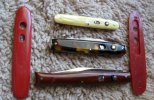Bill DeShivs
Knifemaker / Craftsman / Service Provider
- Joined
- Jun 6, 2000
- Messages
- 12,783
Many (most) of the American-made pocket automatics of the pre-1958 era were made with celluloid handles. These handles deteriorate-releasing nitric acid fumes that will literally eat a knife.
When this deterioration starts the best thing to do is just break the handles off of the knife to save it.
I have hand made these handles many times, but they are a pain in the rear to do correctly. I have messed around with casting them from acrylic with some success but the process is not perfected.
The handles have holes for the button and safety that must be placed exactly. In addition, there is a cutout under these holes for the mechanism..
Being the dinosaur that I am, I only recently thought about 3D printing. Some of the parts that I have seen had visible layers, but I'm sure that is avoidable. If not-and the proper material is used, sanding and polishing the outside is not a problem.
Should someone like to confer with me, I believe I could make you quite a bit of money. I don't want or need to get into the printing business. I already have a laser engraver that I have no idea how to use, and little time to learn! I have the knowledge of how these parts should be made, the characteristics of the material that needs to be used, examples to use as patterns, marketing expertise, connections and the name to sell them.
Anyone intersted?
When this deterioration starts the best thing to do is just break the handles off of the knife to save it.
I have hand made these handles many times, but they are a pain in the rear to do correctly. I have messed around with casting them from acrylic with some success but the process is not perfected.
The handles have holes for the button and safety that must be placed exactly. In addition, there is a cutout under these holes for the mechanism..
Being the dinosaur that I am, I only recently thought about 3D printing. Some of the parts that I have seen had visible layers, but I'm sure that is avoidable. If not-and the proper material is used, sanding and polishing the outside is not a problem.
Should someone like to confer with me, I believe I could make you quite a bit of money. I don't want or need to get into the printing business. I already have a laser engraver that I have no idea how to use, and little time to learn! I have the knowledge of how these parts should be made, the characteristics of the material that needs to be used, examples to use as patterns, marketing expertise, connections and the name to sell them.
Anyone intersted?

